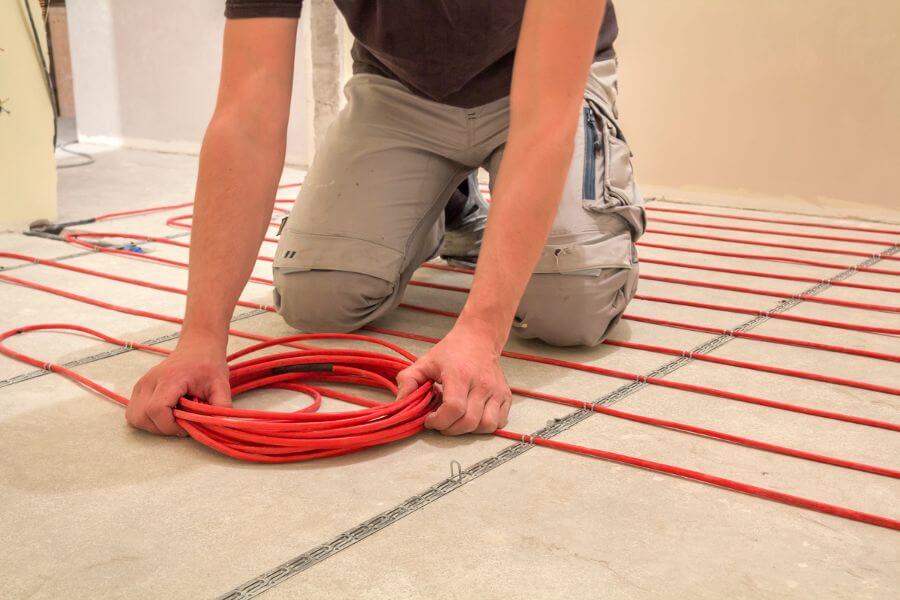Deciding on the best underfloor heating system for your home can be a challenging endeavour. With options like electric and hydronic (water-based) underfloor heating available, it's essential to weigh the pros and cons of each to determine which system aligns with your needs, lifestyle, and budget.
Understanding Underfloor Heating
Underfloor-based heating provides an efficient and uniform way to heat your space by radiating warmth upwards from the floor. Unlike traditional radiators that can create unevenly heated spaces with hot and cold spots, underfloor heating ensures a consistent and comfortable temperature throughout the room.
Electric Underfloor Heating
Electric systems use heating cables or mats installed under the floor to distribute warmth evenly across the room. They are celebrated for their ease of installation and flexibility in heating control.
Pros
- Simplicity in Installation: Ideal for both new builds and renovations, electric systems can be installed without the need for professional help, offering significant savings on labor costs.
- Immediate Warmth: Electric heating systems heat up quickly, providing comfort when you need it.
- Minimal Maintenance: Once installed, these systems are virtually maintenance-free, requiring no ongoing attention.
- No Risk of Water Damage: Unlike hydronic systems, electric underfloor heating carries no risk of leaks or water damage, offering peace of mind to homeowners.
Cons
- Potentially higher operating costs: The cost of electricity can make these systems more expensive to run, particularly if used as the sole source of heating. However, strategic use and smart floor heating thermostats can mitigate these costs.

Hydronic Underfloor Heating
Hydronic systems circulate heated water through pipes beneath the floor. While they are efficient for large areas, they come with their own set of challenges.
Pros
- Efficiency for Large Spaces: Best suited for new constructions, hydronic heating can be a cost-effective solution for whole-house heating.
- Lower Running Costs: In the long term, hydronic systems may offer lower operational costs for extensive heating needs.
Cons
- Complex Installation: Requires professional installation, making it less ideal for retrofit projects.
- Risk of Leaks: The use of water in the system poses a potential risk for leaks, which can lead to significant damage and costly repairs.
- Higher Initial Investment: The installation of a hydronic system involves a higher upfront cost, including the need for a boiler and extensive pipework.

Key Considerations for Your Choice
- When deciding between electric and hydronic underfloor heating, consider the following factors:
- Installation Space: Electric systems are typically less intrusive to install, making them ideal for renovations. Hydronic systems, with their extensive pipework, are better suited for new constructions.
- Running Costs: Hydronic heating generally offers lower running costs, especially in areas where gas is cheaper than electricity.
- Heating Requirements: For supplemental heating in smaller rooms, such as bathrooms, electric underfloor heating is often sufficient. For larger areas or whole-house heating, hydronic systems are more effective.
- Control and Flexibility: Electric systems can be easily controlled with thermostats, including options like the Ditra Heat WiFi thermostat, offering the convenience of adjusting settings remotely.
GTD Supply: Your Partner in Heated Flooring Solutions
At GTD Supply, we specialize in electric underfloor heating solutions, such as the Schluter Ditra floor heating kit, renowned for its reliability and ease of installation. Here’s why we believe electric systems are often the better choice for our clients:
Ease of DIY Installation
Electric floor heating kits are designed for straightforward installation. These kits come complete with a heating cable, DITRA-Heat membrane roll, and a WiFi-enabled thermostat for precise control. This DIY-friendly approach not only saves on installation costs but also allows for custom heating zones tailored to your specific needs.
Safety and Reliability
With no water running beneath your floors, electric systems eliminate the risk of leak-related damage. This aspect is particularly appealing for homeowners concerned about the integrity and longevity of their flooring investments.
Flexibility and Control
Electric systems offer unparalleled control over your heating environment. With the advent of smart thermostats, such as the DITRA-Heat WiFi touchscreen thermostat, you can easily adjust settings for optimal comfort and efficiency, even when you're away from home.

Your Takeaway
Choosing between electric and hydronic underfloor heating systems comes down to your specific needs, budget, and project scope. Electric systems offer simplicity and are ideal for smaller spaces or as supplemental heating. In contrast, hydronic systems are best suited for larger areas and are difficult to install outside of new builds.
At GTD Supply, we are committed to providing our customers with the best in the industry, ensuring your underfloor heating system not only meets but exceeds your expectations. With our industry-leading products and top-rated customer service, we're here to support you every step of the way. For more information or to discuss your project needs, contact us today at our Canada office (905) 660-7600 or our USA toll-free number (866) 660-5758. Let us help you transform your space into a cozy, warm retreat with the perfect underfloor heating solution.







